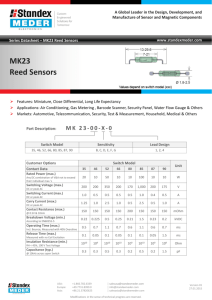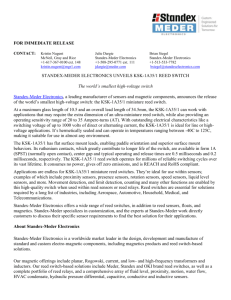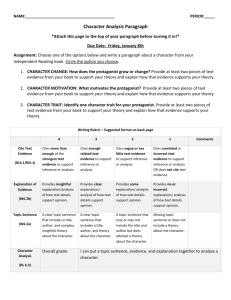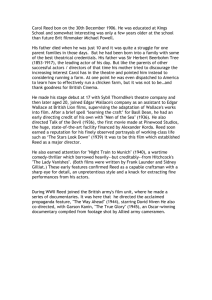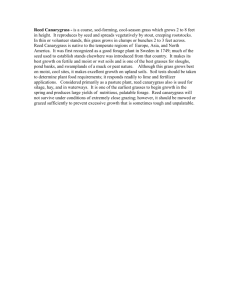Reed Sensors vs. Hall Effect Sensors - Meder Electronics - Digi-Key
advertisement
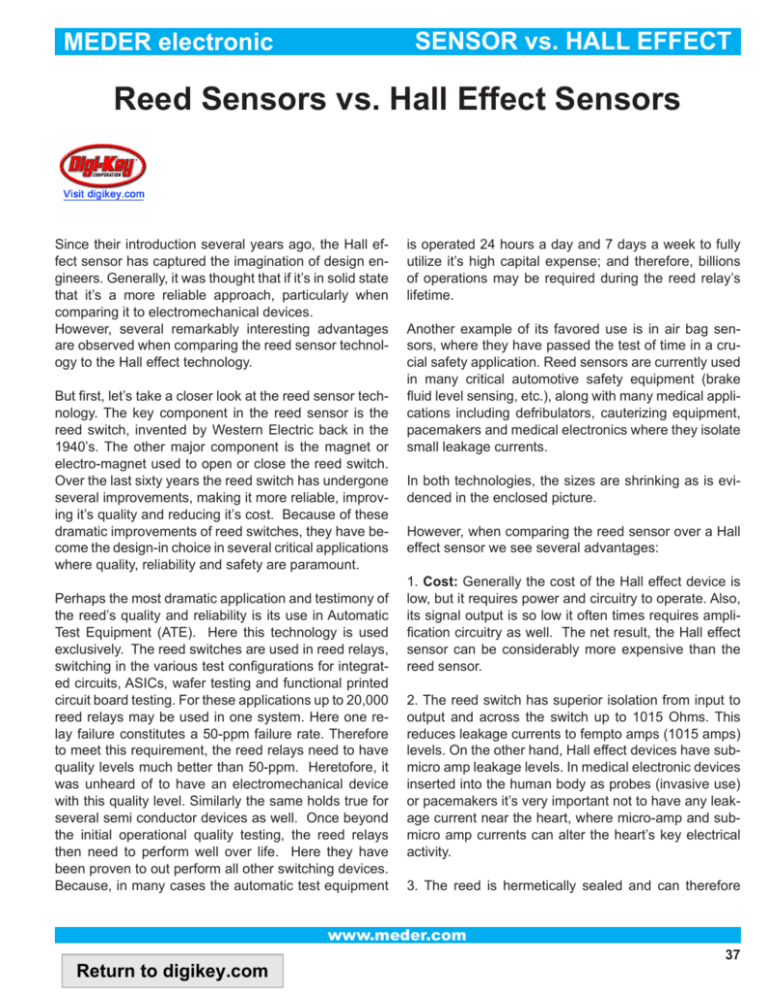
SENSOR vs. HALL EFFECT MEDER electronic Reed Sensors vs. Hall Effect Sensors Since their introduction several years ago, the Hall effect sensor has captured the imagination of design engineers. Generally, it was thought that if it’s in solid state that it’s a more reliable approach, particularly when comparing it to electromechanical devices. However, several remarkably interesting advantages are observed when comparing the reed sensor technology to the Hall effect technology. But first, let’s take a closer look at the reed sensor technology. The key component in the reed sensor is the reed switch, invented by Western Electric back in the 1940’s. The other major component is the magnet or electro-magnet used to open or close the reed switch. Over the last sixty years the reed switch has undergone several improvements, making it more reliable, improving it’s quality and reducing it’s cost. Because of these dramatic improvements of reed switches, they have become the design-in choice in several critical applications where quality, reliability and safety are paramount. Perhaps the most dramatic application and testimony of the reed’s quality and reliability is its use in Automatic Test Equipment (ATE). Here this technology is used exclusively. The reed switches are used in reed relays, switching in the various test configurations for integrated circuits, ASICs, wafer testing and functional printed circuit board testing. For these applications up to 20,000 reed relays may be used in one system. Here one relay failure constitutes a 50-ppm failure rate. Therefore to meet this requirement, the reed relays need to have quality levels much better than 50-ppm. Heretofore, it was unheard of to have an electromechanical device with this quality level. Similarly the same holds true for several semi conductor devices as well. Once beyond the initial operational quality testing, the reed relays then need to perform well over life. Here they have been proven to out perform all other switching devices. Because, in many cases the automatic test equipment is operated 24 hours a day and 7 days a week to fully utilize it’s high capital expense; and therefore, billions of operations may be required during the reed relay’s lifetime. Another example of its favored use is in air bag sensors, where they have passed the test of time in a crucial safety application. Reed sensors are currently used in many critical automotive safety equipment (brake fluid level sensing, etc.), along with many medical applications including defribulators, cauterizing equipment, pacemakers and medical electronics where they isolate small leakage currents. In both technologies, the sizes are shrinking as is evidenced in the enclosed picture. However, when comparing the reed sensor over a Hall effect sensor we see several advantages: 1. Cost: Generally the cost of the Hall effect device is low, but it requires power and circuitry to operate. Also, its signal output is so low it often times requires amplification circuitry as well. The net result, the Hall effect sensor can be considerably more expensive than the reed sensor. 2. The reed switch has superior isolation from input to output and across the switch up to 1015 Ohms. This reduces leakage currents to fempto amps (1015 amps) levels. On the other hand, Hall effect devices have submicro amp leakage levels. In medical electronic devices inserted into the human body as probes (invasive use) or pacemakers it’s very important not to have any leakage current near the heart, where micro-amp and submicro amp currents can alter the heart’s key electrical activity. 3. The reed is hermetically sealed and can therefore www.meder.com 37 Return to digikey.com SENSOR vs. HALL EFFECT operate in almost any environment. 4. The reed has very low on resistance typically as low as 50 milli ohms, whereas the Hall effect can be in the hundreds of ohms. 5. The reed can directly switch a host of load ranging from nano volts to kilovolts, fempto amps to Amps, and DC to 6 GHz. The Hall effect devices have very limited ranges of outputs. 6. The reed sensor has a large range of magnetic sensitivities to offer. 7. Reed sensors are not susceptible to E.D.I., where electrostatic discharge may often times severely damage the Hall effect device. 8. Reed sensors are capable of withstanding much higher voltages (miniature sizes are rated up to 1000 Volts). Hall effect devises need external circuitry for ratings as high as 100 Volts. MEDER electronic 10. The reed sensor is typically tested to withstand a three-foot drop test, which is comparable to the Hall effect sensor. 11. Because the reed sensor has no wearing parts, low level loads (<5V @ 10 mA and below), will operate satisfactorily well into the billions of operations. This rivals semiconductor MTBF figures. 12. The reed sensor is unaffected by the thermal environment, and is typically operated from –50 0C to +150 0C with no special additions, modifications or costs. The Hall effect sensors have a limited operational range. There are many very good applications of reed products. Selection of the proper reed in the proper application, often time is critical. Some reed/relay companies are excellent at designing in reeds in critical applications where quality, reliability and safety are paramount. Fortunately, MEDER electronic is very much involved in several of the critical requirements mentioned above and represents an excellent choice for those critical safety related applications. 9. The reeds are capable of switching a variety of loads, where the Hall effect sensor delivers only smaller voltages and currents. www.meder.com 38 Return to digikey.com MEDER electronic SENSOR vs. HALL EFFECT Comparison of Hall Effect Sensors with Reed Sensor Specifications Hall Effect Sensor Reed Sensor Input requirements External magnetic Field >15 gauss time External magnet field >5 Gauss time Sensing distance Up to 20 mm effectively Up to 40 mm effectively Output requirements Continuous current > 10 mA, depending on sensitivity None Power required all the time Yes No Requirements beyond sensing device Voltage regular, constant current source, hall voltage generator, small-signal amplifier, chopper stabilization, Schmitt trigger, short-circuit protection, external filter, external switch None Hysteresis Fixed usually around 75% Ability to adjust to meet design requirement Detection circuit required Yes, and generally needs amplification None Ability to switch loads directly No, requires external switching Yes, up to 2 A and 1000 V, depending on the reed selection Output switching power Low milliwatts Up to 1000 W, depending on switch selection Voltage switching range Requires external switch 0 to 200 V (1000 V available) Current switching range Requires external switch 0 to 2 A Output sensitivity to polarity Yes, critical for proper operation No Output offset voltage sensitivity Yes, exacerbated by sensitivity to overcoming, temperature dependencies, and thermal stress None Chopper circuit requirement Yes, helps reduce output offset voltage; requires additional external output capacitance None Frequency range Requires external switch DC to 6 GHz Closed output on resistance > 200 Ohm 0.050 Ohm Expected life switching > 5V@ 10 mA > 1 billion operations > 1 billion operations Capacitance across output 100 pF typ 0.2 pF typ Input / Output isolation 1012 Ohm min. 1012 Ohm min. Isolation across output 106 Ohm min. 1012 Ohm min. Output dielectric strength < 10 V typ 205 V typ (2500 V available) EDI (ESD) susceptibility Yes, requires external protection No, requires no external protection Hermeticitiy No Yes Shock > 150 g 150 g (new ones up to 5000 g) Vibration > 50 g 10 g Operating temperature 0 oC bis 70 oC typ above or below range degrades specifications -55 oC to150 oC,no specific degradation Storage temperature -55 oC to 125 oC -55 oC to 150 oC www.meder.com 39 Return to digikey.com
